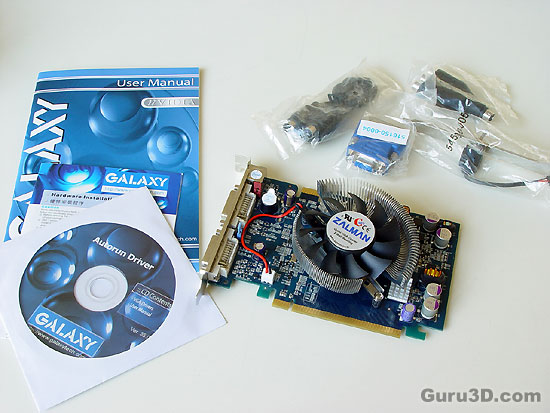Page 3
The bundle
Now we always mention what candy you get included in the box. Obviously with the faster memory, the SmartFlash feature, buzzer feature (we'll discuss both later) and the more expensive Zalman cooler you can't seriously expect much more in the box for the 160 EUR you have to pay for this card.
Notable is the fact that it has two Dual DVI outputs and it is a Zalman cooled graphics card. Cool and Quiet is the name of their game, and it definitely seems to be so on the 7600 GS. Furthermore you'll find a driver CD and manual which unfortunately does not cover the SmartBuzzer and SmartFlash feature.
Furthermore you'll receive a BIOS switcher, one DVI-to-VGA dongle, video out-to-component (3-way RCA) adaptor for TV connection and an S-Video cable. It's adequate to get you connected and for the money versus this cards features absolutely nothing to be ashamed about.

Dual BIOS .. on a graphics card ?
Dual BIOS. It is designed specifically for overclockers and people that are really really afraid ... Let's say you want to overclock or fool around with the BIOS to get some pretty interesting overclocking results eh? You can do that now risk free with Galaxy's SmartFlash . If you fail miserably with your overclock, you simply flip the switch and the card is hardwired to the second backup BIOS. Once you boot up you can flash BIOS A to B again and start over and over until you are satisfied. A pretty interesting idea that is being used on several mainboards for quite some time now.
On the PCB you'll find a jumper, that jumper selects BIOS A or B. You can also connect a (supplied) switch to it.
Dude ... did the card just buzz at me ? Correct. Look at the card photoshoot and you'll notice a red jumper this takes care of enabling/disabling the buzzer. It's so that if the GPU is getting too hot. Set to ~70°C, the buzzer will go bazerk .. Enabling it means leaving the jumper in place, disabling means not shorting the pins (so just hang the jumper off of one). We actually never hit that 70 Degrees but I can imaging that if you OC a lot you might want to remove that jumper.
This really is stuff that only 1% of you would really use .. but it is the small stuff that counts and it's just fantastic to whitness this on a low-cost product for sure.
Now then, back to our usual technical blurb: What are the major advantages of the Series 7 products?
What you need to remember is that any Series 6 and 7 graphics card can achieve what a modern game expects from it. Obviously the keyword over the past couple of years has been "Shader technology." It really changed the way we look at games from a graphical point of view. It allows the game programmers to take games to a next level in both a visual and performance terms.
As always, that's the point where we land and quickly discuss on Shader Model 3.
Talking about Shader Model 3
If you program or play computer games or even recently attempted to purchase a video card, then you will have no doubt heard the terms "Vertex Shader" and "Pixel Shader". The step from 2.0 to 3.0 was a small one and most Shader Model 2.0 games can easily be upgraded to Model 3.0, which can bring more performance to that gaming experience. DirectX 9 was recently updated and we are going to see more and more support for 3.0 Shaders.
Is SM 3.0 technology a huge visual advantage over 2.0? Nope, not even the slightest bit. Yet any technological advantage is always welcome and preferred over a previous generation's development. What you need to remember about Shaders 3.0 is that it can and will be used only in several critical places where it can give a performance boost and graphics cards are all about performance my friends. Both ATI and NVIDIA now offer Shader Model 3 support in their new products. GeForce Series 6 and newer models and for ATI their X1000 series and newer models.
Talking about HDR
Another big trendy implementation that will bring games closer to a movie like quality experience is HDR.
Both ATI and NVIDIA
have been focusing extremely hard on HDR. They put a lot of money into their technology to support HDR in the best possible way and they should as it just is a fantastic effect that brings so much more to the your gameplay experience. HDR is something you all know from games like Far Cry. It's extremely bright lighting that brings a really cool cinematic effect to gaming. This effect is becoming extraordinarily popular.Valve recently released a new HL2 level in the form of Half Life 2: Lost Coast. Go download it as it'll show and amaze you what HDR can do. The difference is obvious. HDR means High Dynamic Range. HDR facilitates the use of color values way beyond the normal range of the color palette in an effort to produce a more extreme form of lighting rendering. Typically this trick is used to contrast really dark scenery. Extreme sunlight, over-saturation or over exposure is a good example of what exactly is possible. The most simple way to describe it would be controlling the amount of light used present in a certain position in a 3D scene.



Half Life 2 - Lost Coast level. If you bought the game, available for free on Steam.
HDR is already present in Far Cry, 3DMark06, Splinter Cell: Chaos Theory, Age ov Empires IV, Serious Sam 2 and in Half Life 2: Lost Coast. It will be available in Unreal 3 and likely a large number of other games soon. Let the screenshots do the talking as it really is a cool technology.
